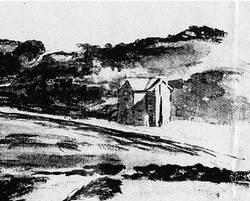Toll roads in Sydney – a scourge of the motorist or an essential means of paying for improved public infrastructure? Whichever end of the spectrum you swing towards, one thing is for sure – toll roads are not a modern day concept!
In 1861 the New South Wales Governor John Young officially declared: ‘…I appoint and direct that the Randwick Road, at the intersection of the old Botany Road, and the continuation of Cleveland Street be a place at which Toll shall be demanded, levied and taken…’.
So, toll roads are nothing new in this city!
Toll roads go back a long way!
The collection of tolls on Sydney’s early roads was an British concept adopted by the Colony. From the early 1800’s in Sydney there were toll houses acting as gateways along the major roads that form the underlying structure of our metropolitan road system.
As is still the case today, the system required road users to pay a fee which was then used for road maintenance – a critical revenue making enterprise as the settlement expanded its population and infrastructure.
Toll bars were usually installed at the junctions of key thoroughfares and typically, a toll house was built nearby to provide a home for the toll collector and his family. The toll houses were usually simple structures, often featuring bay windows to allow the collector a clear view of any approaching traffic (interested in knowing more? Seriously? OK, then read more about the history of Sydney’s roads and toll roads).
A tale of two toll houses…
Centennial Parklands (before it was the Centennial Parklands we know today) actually featured two toll houses.
 Randwick toll house by Samuel Elyard
Randwick toll house by Samuel Elyard
-
Toll House #1: was located in at the intersection of Anzac Parade (formerly Randwick Road) and Alison Road on a small triangular pocket of land now called Tay Reserve in 1847. It was later demolished in 1909.
-
Toll House #2: was located in Moore Park at the intersection of Anzac Parade and Cleveland Street, adjacent to Moore Park Golf and opened in 1860 – where it still stands today.
This latter toll house was erected one year prior to the opening of the Randwick Racecourse and it also became known as ‘Randwick Toll Gate’. It operated until 1890. Revenue raised was used the the State to fund road construction and maintenance across NSW.
As a side point, during the 1860s Mr Billy Timbery (“King Billy”) worked the tollgates in Moore Park. King Billy was believed to be the first Aboriginal person officially employed in the Centennial Parklands area. Mr Billy Timbery was a well-known local personality and had a close association with the Wentworth family, also being employed at their Elizabeth Bay house (Vaucluse House).
During these times, tolls would have been taken by hand from people on horseback and other non-motorised transport.
Legislation set the amount which could be charged for tolls. At this location, a toll of ‘one farthing’ was charged for the transportation of sheep, lambs, pigs and goats, whilst cattle, horses, carts, drays, wagons and coaches attracted a fee of up to ‘one shilling’.
A significant building
It is the only surviving metropolitan toll house and the only two-storey toll house in NSW.
In its original sandstone form, it is representative of Victorian, gothic-style architecture, featuring a T-shaped configuration with a central bay to allow a line of sight for the oncoming traffic.
No more tolls…
The introduction of the rail system in the 1870s led to the decline of relevance of the toll house. Road use declined and traffic congestion made the collection of tolls inefficient and frustrating for road users.
Toll collections ceased in 1890, and from 1913 to 1926 the toll house was transformed into a clubhouse for golfers at Moore Park Golf.
View of the Moore Park Toll House in 1929 (from Moore Park Golf House). In the distance you can make out the Hordern Pavilion.
While it has had a number of periodic uses, the building has been modified and added to over the years, and most recently used as a support depot for staff from NSW Public Works until 1999, then a maintenance depot for Moore Park Golf.
In 2000 the building was listed on the State Heritage Register.
A reminder of the past or a bright future?
The Moore Park Toll House has lay dormant and unused for many years now. As with all heritage buildings, without routine maintenance and improvement they can deteriorate rapidly.
In anticipation of the Moore Park 150th Birthday in 2016, the Trustees of the Centennial Park and Moore Park Trust have indicated that it will invest in the stabilisation and refurbishment of the heritage building, with the intention of undertaking a later adaptive reuse project to bring new life back to this wonderful part of Sydney’s history.